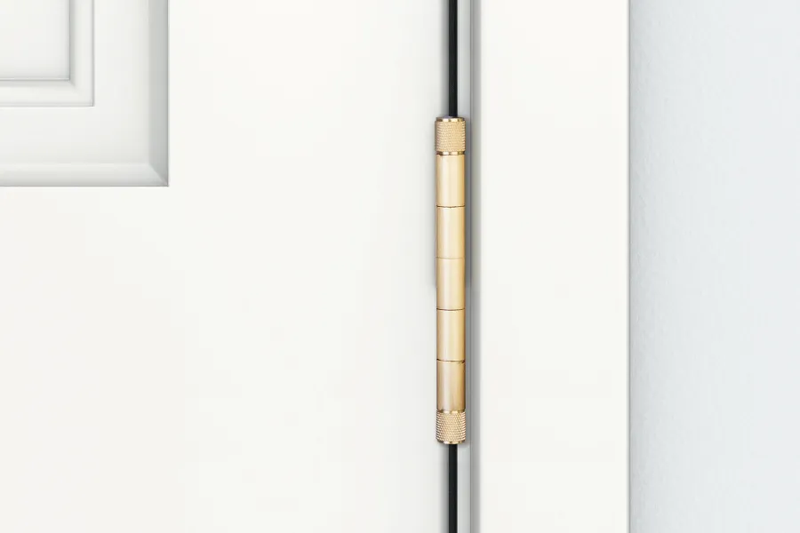Hardware Basics | Tips and Tricks
All About Hinges
Door hinges serve as the mechanical joints that allow doors to swing open and closed smoothly. They play a crucial role in the functionality and longevity of doors, supporting their weight, size and dimensions, and enabling seamless movement. Paying attention to specifics such as hinge size, material, functional and type is important as it ensures proper door operation, durability, and aesthetic compatibility with the overall design scheme, ultimately enhancing both the functionality and appearance of the doors within a space.
Here, we'll explore some frequently asked questions about hinges:
Does Size Really Matter?
Determining the right size of hinges to order depends on several factors, including the type of door you are installing them on and the weight and dimensions of that door or cabinet.
Here are the steps to help you choose the correct hinge size:
- Identify the Type of Door:
Determine whether you are installing hinges on a door, or another type of application. - Measure the height, width, and thickness of the door.
- Estimate the weight of the door. If it's a door, consider its material (wood, metal, glass, etc.) and any additional factors such as glass panels, which can add weight.
- Consider the Number of Hinges:
For standard interior doors, two hinges are often sufficient. However, heavier or taller doors may require three hinges. - Choose the Hinge Type:
Select the type of hinge you need based on your application (see more below) - Determine the Required Size:
The size of the hinge is typically specified in terms of height and width (e.g., 3" x 3" or 4" x 4"). The first measurement refers to the height of the hinge leaf, and the second measurement refers to the width. Choose a hinge size that matches the dimensions of your door or cabinet, ensuring it can adequately support the weight. - Verify Other Features:
- Consider additional features or requirements, such as finish, hinge style, and hinge swing direction (left-hand or right-hand swing).
Keep in mind that it's always a good practice to consult with a hardware professional or the manufacturer if you have any doubts or if your application is unique. They can provide guidance and ensure you select the right hinges for your specific needs.
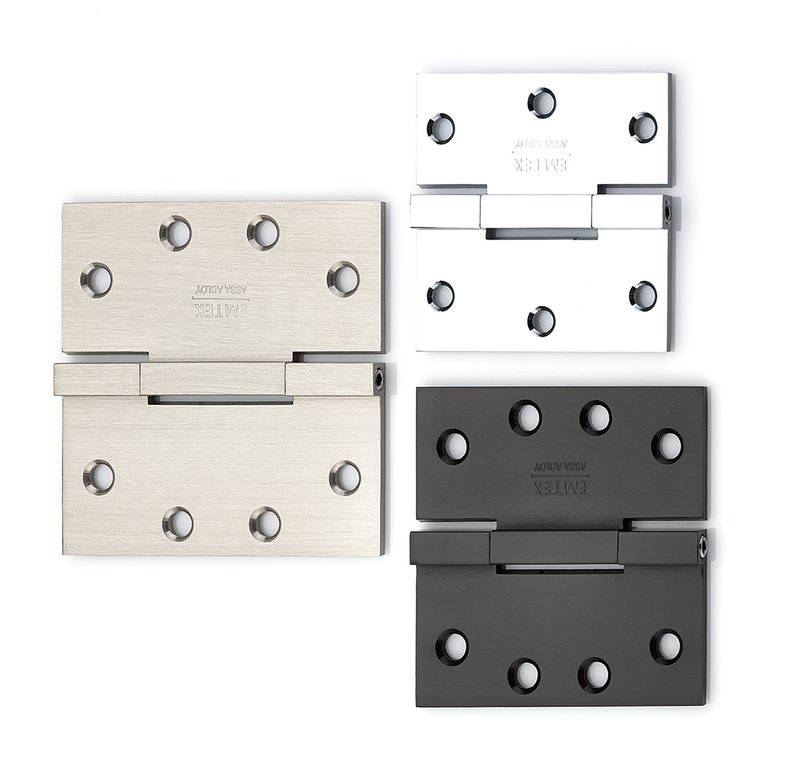
What about base material?
While most of Emtek's hinges are solid brass, we do offer a plated steel option that is more economical. If you are trying to be more cost effective when buying large quantities of hinges, plated steel might be a good bet. A stainless steel option can also be a good bet for silver finishes like satin nickel.
Additionally, if you are trying to match a brass color door knob or lever, sticking to a solid brass hinge will be a better match than plated steel.
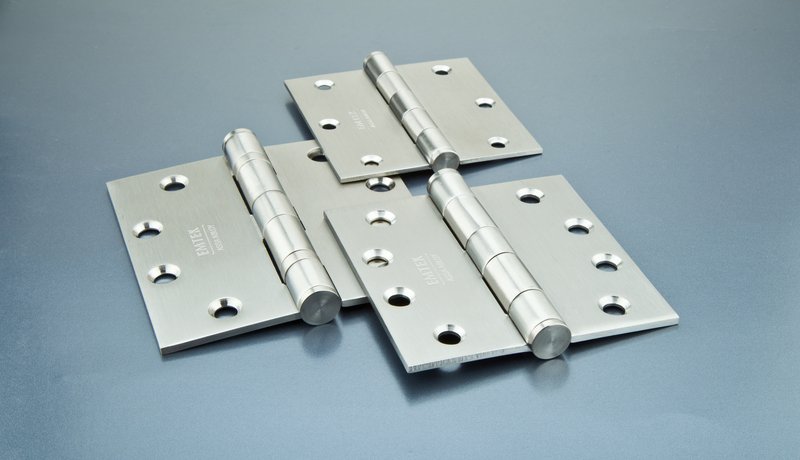
Do I need Residential or Heavy Duty Hinges?
Residential and heavy-duty hinges differ primarily in terms of their construction, load-bearing capacity, and durability.
Residential Hinges:
- Designed for typical interior doors. Lower load-bearing capacity and are suitable for doors that are not excessively heavy or frequently used.
- Generally less robust and may have a shorter lifespan when subjected to heavy use. More suitable for the relatively low-stress conditions.
- May be made from steel, brass, or other materials, and they often feature decorative finishes. Designed to blend with the aesthetics of a home.
- Suitable for interior and exterior residential doors, and other low-traffic areas in homes.
Heavy-Duty Hinges:
- Built to handle substantial weight and high traffic. Commonly used in commercial and industrial settings where doors are larger, thicker, and subjected to constant use and abuse.
- Constructed with durability in mind first. Often made from stronger materials, have reinforced components, and are designed to withstand the wear and tear of high-traffic environments.
- Typically made from tougher materials like stainless steel or other alloys. Design focuses more on strength and durability than aesthetics.
- Find applications in commercial and industrial settings, such as schools, hospitals, warehouses, and industrial facilities, where doors are larger, heavier, and experience frequent use.
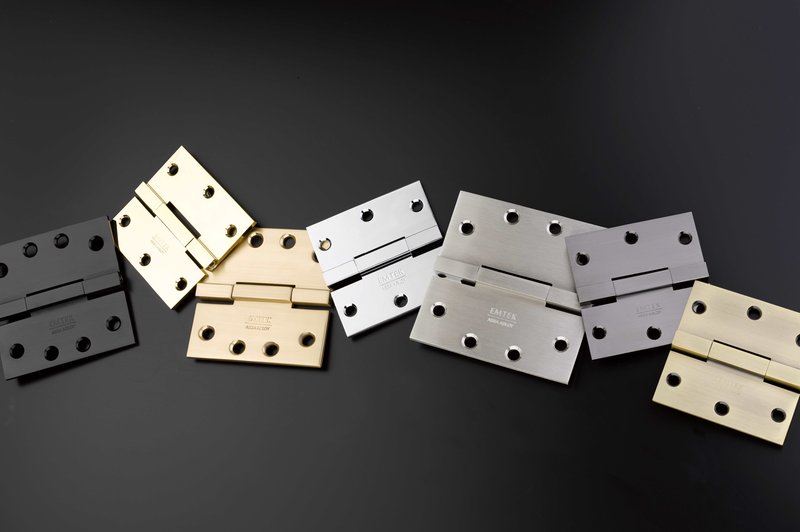
What about Plain Bearing or Ball Bearing?
Plain Bearing Hinges:
- A simple and cost-effective design. Consist of a simple, unsealed, and non-friction-reducing pin that rotates within the hinge knuckles. Design does not incorporate any additional bearings or mechanisms to reduce friction.
- Do not provide the same level of smooth operation and long-term durability as ball bearing hinges. More susceptible to wear and friction, which can lead to squeaking.
- Generally suitable for doors with standard weight and usage. Often used in residential and light commercial applications.
- May require more frequent maintenance, such as lubrication, to prevent wear and ensure smooth operation
Ball Bearing Hinges:
- Feature ball bearings within the hinge knuckles. These bearings reduce friction and create a smoother and more durable pivot point for the hinge, allowing for easier door movement but can come at a premium
- Offer a significantly smoother operation and greater durability. Ball bearings effectively reduce friction, resulting in quieter, longer-lasting performance. They are ideal for high-traffic areas and heavy doors.
- Designed to support heavier doors and withstand frequent use. Commonly used in commercial and industrial settings and for heavy exterior doors.
- Require less maintenance due to their reduced friction and increased durability.
Do Base Materials Matter?
Steel Hinges:
Pros:
- Affordability: Steel hinges are generally more affordable compared to brass hinges. They are widely available and mass-produced, leading to lower production costs.
- Strength: Steel is known for its strength and durability, making steel hinges suitable for heavy doors or high-traffic areas.
- Corrosion Resistance: Many steel hinges are coated with finishes like zinc plating or powder coating, providing protection against rust and corrosion, especially in outdoor or damp environments.
Cons:
- Appearance: Steel hinges may lack the aesthetic appeal of brass hinges. While they can be finished in various colors, they often have a more industrial or utilitarian look.
- Weight: Steel hinges tend to be heavier than brass hinges, which can be a consideration for certain applications, especially if weight is a concern.
- Durability: While steel is durable, it may not offer the same longevity as brass in terms of maintaining its appearance over time. Steel finishes can wear down, exposing the underlying metal to corrosion.
Brass Hinges:
Pros:
- Appearance: Brass hinges are prized for their warm, golden appearance, which adds a touch of elegance to doors and cabinets. They often have intricate designs and can enhance the overall aesthetic of a space, and are a closer finish match to traditional brass finishes on your door hardware in most instances.
- Corrosion Resistance: Brass is highly resistant to corrosion, making brass hinges suitable for both indoor and outdoor applications, particularly in humid or coastal environments.
- Durability: Brass is a durable metal that maintains its appearance well over time. It is less prone to tarnishing or discoloration compared to steel, providing long-lasting beauty.
Cons:
- Cost: Brass hinges are typically more expensive than steel hinges due to the higher cost of the raw material and the additional craftsmanship required for their production.
- Softness: Brass is a softer metal compared to steel, which may make brass hinges more susceptible to dents and scratches, particularly in high-traffic areas.
- Maintenance: While brass is corrosion-resistant, it may require occasional polishing to maintain its shine and prevent tarnishing, which can add to the overall maintenance cost.
In summary, steel hinges offer affordability and strength but may lack the aesthetic appeal and durability of brass hinges. Brass hinges, while more expensive, provide a luxurious appearance, superior corrosion resistance, and long-term durability, making them a preferred choice for certain applications where aesthetics and longevity are paramount.
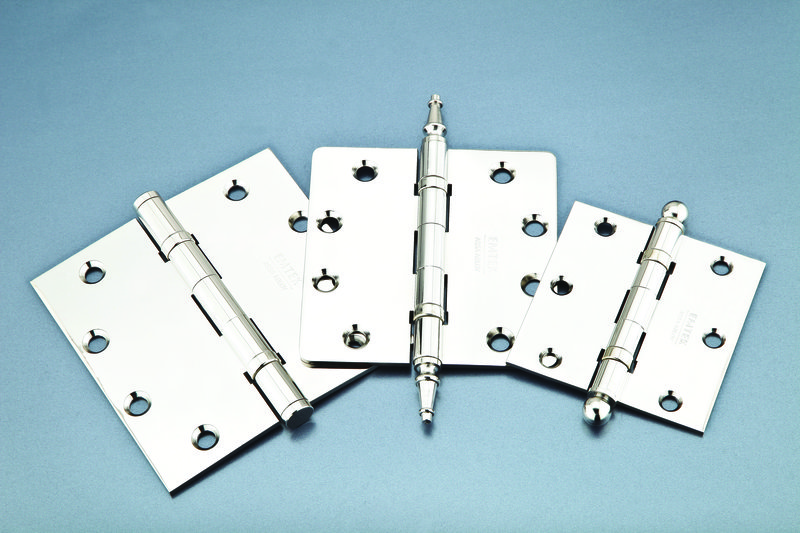
What about accessories?
Hinge tips can be a fun and decorative or historically accurate feature to add to the tops and bottoms of your hinges. Hinge tips, also known as hinge finials or hinge pins, serve several important purposes as well.
- Aesthetic Enhancement: Hinge tips are often decorative elements that enhance the overall appearance of the hinge and the door. They come in various designs and finishes to complement the style of the application and provide an elegant or ornamental touch.
- Concealing Fasteners: Hinge tips can hide the screws or fasteners used to attach the hinge to the door frame or cabinet. This creates a cleaner and more polished appearance by concealing the hardware and reducing its visibility.
- Security and Tamper Resistance: In some cases, hinge tips may include security features to deter tampering or unauthorized removal of doors. These may have designs that make it more challenging to access and manipulate the hinge pin, enhancing the security of the installation.
- Protecting Against Pin Removal: Hinge tips can help prevent the removal of hinge pins, which are essential for the hinge to function. By enclosing the top of the hinge pin, they make it more difficult for someone to disassemble the hinge and potentially remove a door.
- Noise Reduction: Some hinge tips are designed with materials or features that reduce noise, making doors close quietly and smoothly. These may be especially useful in residential or commercial settings where quiet operation is desirable.
- Functionality: While decorative in many cases, hinge tips can also play a functional role. For instance, some ball bearing hinges use finial tips to maintain the alignment of the ball bearings within the hinge, contributing to the hinge's smooth operation and durability.
The specific purpose and design of hinge tips can vary depending on the type and style of hinge and the manufacturer. They serve both functional and aesthetic roles, contributing to the overall performance and appearance of doors, cabinets, and other hinge-related applications.
